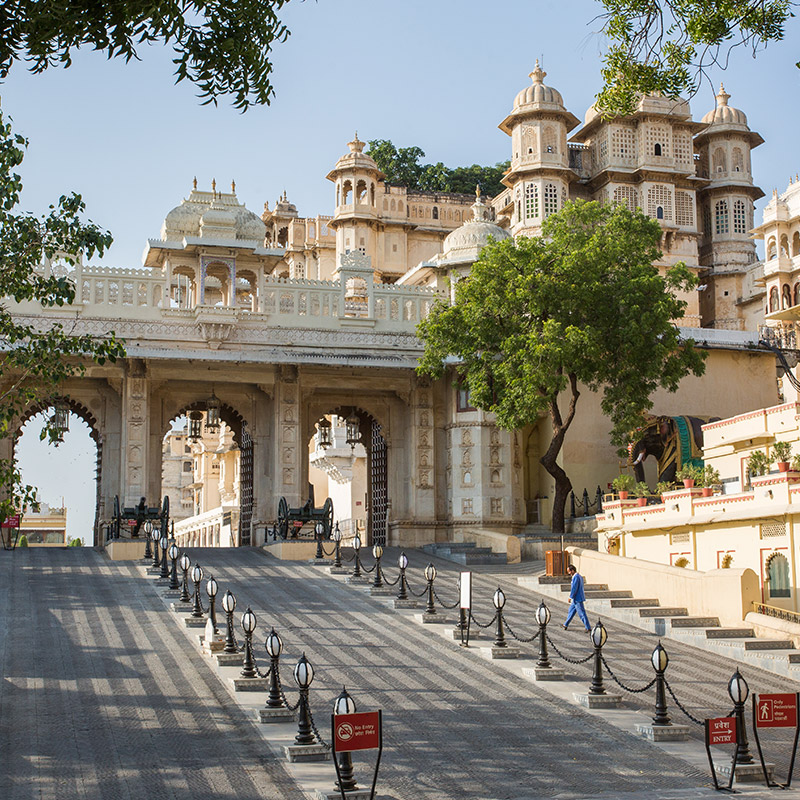The Udaipur City Palace is one of the most iconic landmarks of Rajasthan and a symbol of the grandeur of the Mewar dynasty. Nestled along the shores of the serene Lake Pichola, this magnificent palace complex is an architectural masterpiece that showcases the rich heritage, art, and culture of Udaipur. Built over a period of nearly 400 years, the palace stands as a testament to the power and prosperity of the Sisodia Rajputs.
History and Construction
The foundation of the Udaipur City Palace was laid in 1559 by Maharana Udai Singh II, the founder of Udaipur. After the fall of Chittorgarh to the Mughal emperor Akbar, Udai Singh II moved the capital of Mewar to Udaipur and began the construction of this grand palace. Successive Maharanas continued to expand and enhance the structure, resulting in a sprawling complex of palaces, courtyards, pavilions, terraces, and gardens.
The palace complex is a blend of Rajasthani, Mughal, European, and Chinese architectural styles, making it one of the most fascinating and unique royal residences in India. Over the centuries, various rulers contributed to its expansion, adding elements that reflected their artistic and cultural influences.
Architectural Marvels
The City Palace is a series of interconnected palaces built on a ridge, offering breathtaking views of Lake Pichola, Jag Mandir, and the surrounding Aravalli Hills. The entire complex is made of granite and marble, featuring intricate carvings, ornate balconies, towering domes, and elaborate courtyards.
- Tripolia Gate and Badi Pol: The main entrance to the palace is through the Tripolia Gate, built in 1725. This three-arched gate leads to the main palace and is used during royal processions. Another significant entrance is the Badi Pol, which adds to the grandeur of the palace.
- Amar Vilas: The highest point of the palace, Amar Vilas, is a beautiful pavilion with a lush garden, hanging balconies, and fountains. It serves as a pleasure retreat and offers stunning panoramic views of the city and lake.
- Sheesh Mahal (Palace of Mirrors): The Sheesh Mahal is a mesmerizing section of the palace adorned with intricate mirror work. It was built by Maharana Pratap for his queen and is a splendid example of Rajput aesthetics.
- Manak Mahal: This palace section is decorated with beautiful crystal and porcelain figures. The sun emblem displayed in the hall symbolizes the royal lineage of the Mewar rulers, who considered themselves descendants of the Sun God.
- Zenana Mahal (Queen’s Palace): The Zenana Mahal, or the women’s quarters, is adorned with exquisite paintings, frescoes, and delicate mirror work. It showcases the luxurious lifestyle of the queens of Mewar.
- Durbar Hall: Built in 1909, the Durbar Hall is an imposing chamber used for official meetings and royal ceremonies. The massive chandeliers, paintings, and artifacts add to its regal charm.
- Crystal Gallery: The Crystal Gallery houses a remarkable collection of crystal furniture, including chairs, tables, beds, and even a crystal throne. These artifacts were ordered by Maharana Sajjan Singh from England in the late 19th century but arrived after his demise.
Museums and Exhibits
A significant portion of the City Palace has been converted into museums that offer a glimpse into the rich history of the Mewar dynasty. The City Palace Museum, managed by the Maharana of Mewar Charitable Foundation, showcases a vast collection of royal artifacts, including paintings, weapons, costumes, and antique furniture. The museum is divided into various sections, each dedicated to different aspects of Mewar’s glorious past.
Lake Pichola and the City Palace
The City Palace’s scenic location along Lake Pichola enhances its charm. The palace complex extends into the lake, offering stunning reflections in the water, especially during sunrise and sunset. Visitors can take boat rides on Lake Pichola to admire the palace’s grandeur from a unique perspective. Jag Mandir and Jag Niwas (Lake Palace) are two other beautiful islands visible from the palace.
Cultural Significance and Events
The City Palace remains an important cultural hub in Udaipur. It serves as a venue for royal weddings, cultural events, and festivals. The annual Mewar Festival and Holika Dahan celebrations take place here with great enthusiasm. The palace also hosts sound and light shows that narrate the history of Udaipur and the Mewar dynasty, adding a mesmerizing touch to the visitor experience.
Tourist Experience and Visitor Information
The City Palace is one of the most visited tourist attractions in Udaipur. It is open to visitors throughout the year, with guided tours available to explore its various sections. The entrance fee varies for Indian and foreign tourists, and additional charges apply for photography and access to specific exhibits like the Crystal Gallery.
Timings: The palace is open daily from 9:30 AM to 5:30 PM.
Entry Fee: Varies depending on access to different sections of the palace.
For a more immersive experience, visitors are encouraged to hire a local guide who can provide historical insights and stories about the palace and its rulers.
